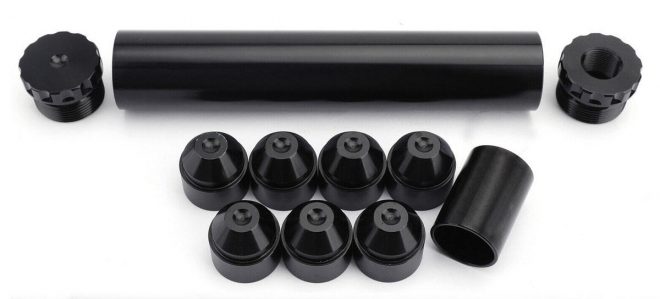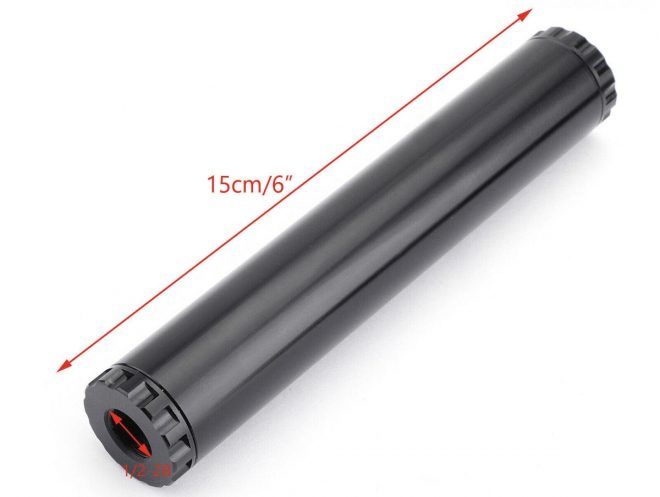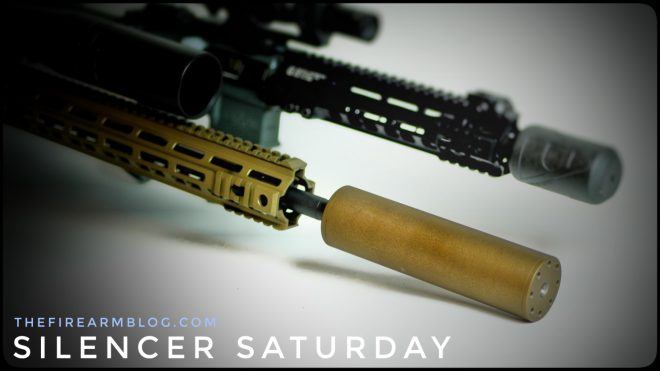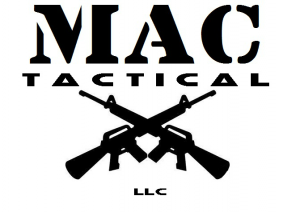Welcome back to another edition of TFB’s Silencer Saturday, where dreams come true (after paying your $200 to the Crown). Last week we used the Dead Air Odessa and Wolfman as examples of two types of modular suppressors. As the story goes, it all comes down to you mission requirements – that’s a fancy way of saying “what the heck are you planning on doing with your silencer, hoss?” Today we will dig into a slightly controversial topic: solvent trap kits. Why are they controversial? We’ll get into that in a second.
TFB’s Adam Scepaniak has turned our Best Silencer edition into August’s Reader’s Choice Awards. Please go vote for your favorite suppressor in each category: rimfire, pistol, rifle and specialty. Hopefully by mid-month I’ll have some giveaway prizes lined up for a few lucky readers.
SILENCER SATURDAY #84: Are Solvent Trap Kits A Good Idea?
Back to the topic at hand: Solvent Trap Kits. First off, what are solvent traps? Designed to be threaded onto the end of a barrel, solvent traps are used to catch oils and solvents while you clean barrel. Instead of the liquids draining onto your living room floor while you are watching Heat or Private Benjamin, the solvent trap catches it in the “reservoir” at the end of the barrel. Nifty. I’ve always just used a rag, but nifty nonetheless. While the end caps of these kits are threaded in 1/2×28 or other common pitches, the end caps and cups are not bored out as they would be in a suppressor.
But why are solvent trap kits considered a dirty word in certain circles? In the pre-internet days (and probably still to this day) solvent trap kits were sold at gun shows with a wink and a nod as do-it-yourself silencer kits. Whether the buyer was planning on using the ATF Form 1 process to legally make an NFA controlled device or would risk a mandatory minimum 10 year sentence upon conviction, was up to the individual.
The reason that these collections of metal cups and a tube are called solvent trap kits and not 80% silencer kits has everything to do with semantics. By law, silencer parts are controlled by the NFA, and the stages of the manufacturing process isn’t exactly cut and dry. So while possessing solvent trap cups is perfectly legal, possessing incomplete silencer baffles without an approved Form 1 is not, even if they are one in the same. Maddening, right?
Fast forward to modern day times, when internet retailers like Amazon sell solvent trap kits online. My guess is that the market for these devices are the same as it is at gun shows: 1% end up as solvent traps, 99% end up as suppressors. Breaking that 99% up into Form 1 approved versus unregistered silencers would be a more interesting study. Not that I personally care – individual liberties and what not.
So let’s return to the crux of the issue: are solvent trap kits worth it? To answer this question, we need to make a few assumptions. First, we will assume that everyone who is looking to build a silencer will be following the rules and regulations of the NFA. If you are unfamiliar with the ATF Form 1 application process, I suggest using the eForm system since approvals are still coming back in about two weeks. We’ve put together a step-by-step eForm tutorial that can be found here. While I believe the NFA is stupid and people should be able to build whatever they want as long it doesn’t infringe on anyone else, I would never suggest breaking any laws.
The second assumption I will make is that the silencer maker is reasonably handy with basic tools: drills, vises sandpaper/steel wool. Most kits can be converted to silencers with the same amount of knowledge and skill that it takes to install a window air conditioning unit.
And lastly, I’m going to assume that if you are considering making a solvent trap kit into a silencer that you are focused on saving money. Most kits are fairly basic and don’t include efficient baffle designs, shielded cores for easier cleaning or are not made to be the lightest weight possible. A reputable manufacturer with a proven design will most likely sound better, weigh less, last longer and have a more aesthetically pleasing look than a silencer made from a solvent trap kit. Don’t get offended, I’m sure yours is great.
My opinion:
So, with those three caveats in mind, yes, I believe solvent trap kits can be worthwhile. For one, there is a certain satisfaction to building a a device that will quiet your gun. You will also have a better appreciation for the amount of engineering that goes into a commercially built suppressor. Since eForms are only available for Form 1s and not Form 4s (transfers) you’ll have a working silencer in about two weeks. And lastly you will probably save a good amount of money.
I’ll caution any prospective builders by suggesting they stick to rimfire setups because of the lower pressures involved. Or p, if you are planning on building a a pistol or rifle suppressor, stick with a reputable dealer instead of a $9.99 Chinese made kit.
I still plan on releasing a part two of our popular Build Your Own Silencer series. Stay tuned.
Be safe, have fun and we’ll see you next week for TFB’s Silencer Saturday.
11 Pcs Aluminum 1/2-28 Fuel Trap Solvent Filter For NAPA 4003 WIX 24003 Auto Filters 1×6 Black – $9.99

SILENCER SATURDAY #84: Are Solvent Trap Kits A Good Idea?

SILENCER SATURDAY #84: Are Solvent Trap Kits A Good Idea?

SILENCER SATURDAY #84: Are Solvent Trap Kits A Good Idea?

SILENCER SATURDAY #84: Are Solvent Trap Kits A Good Idea?
Silencer Saturday is Sponsored by Yankee Hill Machine:
Buy YHM silencers and accessories at:
Silencer Shop – Hansohn BrOthers – dead eye gun supply –
Mac tactical
All YHM Products At Brownells
DEALERS: If you want your link to buy YHM suppressors included in future Silencer Saturday posts, email: silencers@thefirearmblog.com
 Your Privacy Choices
Your Privacy Choices






